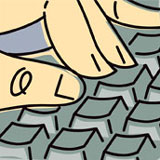The ambulance weaved through the early afternoon traffic with sirens blaring and lights flashing.
On a gurney inside the ambulance, attended by paramedics, lay Ben, a roofing worker with Metro Roofing Co. It seemed only moments before he had been on a roof with his fellow workers applying a single-ply membrane.
Ben did not know what had happened—there had been an explosion and burst of flame. He remembered searing heat enveloping the right side of his body.
On the way to the hospital, Ben tried to piece together the events that led to the explosion.
The crew members had been installing a single-ply roof system on a small office building. Just before noon, they applied adhesive to a recessed storage area surrounded by a short wall on three sides. Because the adhesive needed time to set for the installation of the single-ply membrane, the crew took a break for a quick lunch. Some stacked pails of adhesive remained nearby.
When the workers returned a half-hour later, they positioned a single-ply roll and began to apply it over the adhesive. Suddenly, there was a hot, bright flash and roaring sound. Flames were everywhere. Most of the crew managed to escape to safety, but Ben, who was working closest to the cans of adhesive, bore the brunt of the explosion.
Ben wondered whether anyone else had been hurt. He looked at the paramedic to ask about the other workers but couldn't summon the strength.
Ben had attended plenty of safety training courses while at Metro Roofing. His education included safety training with regard to fall protection, material handling, the use of personal protective equipment, avoiding electrical hazards and the potential hazards of working in confined spaces.
Ben had a good memory and, over time, became familiar with the Occupational Safety and Health Administration regulations about working in confined spaces. He knew that to help avoid a fire, containers of flammable material should be grounded so sparks generated by static electricity would be far less likely to ignite materials.
During his safety training, Ben had learned static electricity often is a potential hazard on roofing jobs. It can be generated by various things, such as pressurized liquid running through a hose or unrolling a single-ply roll.
The day the accident occurred had been hot and dry with no breeze. The area they were working in had been partially enclosed, providing a perfect space for combustible fumes to linger. The fumes were heavier than air and had gathered instead of dissipated. Applying the single-ply roll had generated enough static electricity to ignite the adhesive fumes and cause an explosion.
Ben and his crew members should have remembered that if a fan is used to dissipate fumes, it should be set up properly so fumes are pushed away from the fan's electric motor. If the fumes are drawn back into the motor, they can ignite.
The rest of the crew had ignored the simple safety regulations as Ben had. It wouldn't have taken much time to ensure the job site was safe. The regulations existed to help avoid an accident. And even though the crew members were familiar with the regulations, they couldn't be bothered with the regulations and didn't think they were a big deal. They figured such an accident would never happen to them.
Ben became aware of a voice and slowly opened his eyes. The paramedic was speaking to him.
"Sir, we're at the emergency room," the paramedic said. "We're going to move you inside now. Just hang in there, OK?"
The nurses drew curtains around Ben. A doctor's face leaned close and peered at him.
Ben felt cold. There was a burst of activity around him, and Ben heard more voices—they were hushed but urgent.
"Doctor, his pulse is dropping."
"Nurse, get the paddles."
Ben closed his eyes.
"Flatline, doctor."
"Clear!"
Peter Greenbaum is NRCA's manager of education programs.


